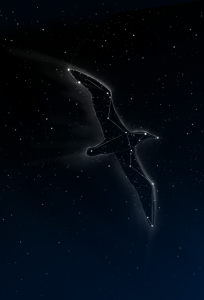An essay by Dr. Simon Rulik, as provided by Christopher David DiCicco
Art by Leigh Legler
When the shuttle blasted off, launching me outside Earth’s orbit, it wasn’t Sara I thought of or even the kids–it was the PBS animal documentary on migrating albatrosses.
I’d sat the evening before in my family room with the lights dimmed, a pillow propped against my chest for security. Both Jason and Gayle had fallen asleep next to me. Sara leaned over, wrapped her arm around my neck, kissed me, saying, “Don’t worry about it, spaceman. I’ll put them to bed. What’s one more night?”
I got the message, carried Jason to bed, kissed his forehead, thought how I might die in space, that this might be the last time I saw him.
I kissed Jason again, fluttered over to Gayle’s doorway, held Sara there–as light as air. We watched our little darling Gayle breathe in, breathe out, our own respiration matching her falling chest.
Later, I sat back on the sofa, watched television, absorbed the details. The albatross flew across the Atlantic. It used thermo updrafts from islands along the way to gain great height. The warm land baked under the sun produced an advantage to soar from, drifting the bird across, away to where it wanted, needed, to go.
#
In the shuttle, I considered the moon. How I would soon walk on it, ending the first half, the greatest half, of the journey. The dangerous trip was always half-drifting home.

“Roger. We need the size of the meteorite relative to your hand and the distance between it and your helmet. Count the seconds before the meteor appears larger than your fist. If it doesn’t appear significantly larger in five, then it’s not going to hurt you.”
“It’s a bird.”
To read the rest of this story, check out the Mad Scientist Journal: Summer 2014 collection.
Dr. Simon Rulik originally headed Edinburgh’s Aviary Institute, specializing in the study of flight and extended travel patterns there before switching directions and joining London’s esteemed Moon to Stars Exploratory Program where he now examines the effect of space travel on humans. Dr. Simon Rulik theorizes that one day we may learn how to ride the coat-tails of exploding stars from one moon to the next, making our way through this crazy thing we call a galaxy.
Christopher David DiCicco loves his wife and children—not writing minimalist stories. But he does. Work in Superstition Review, Bartleby Snopes, Nib, Litro, WhiskeyPaper, The Cossack and other fine publications. Visit www.cddicicco.com for more published work.
Leigh’s professional title is “illustrator,” but that’s just a nice word for “monster-maker,” in this case. More information about them can be found at http://leighlegler.carbonmade.com/.
Follow us online: